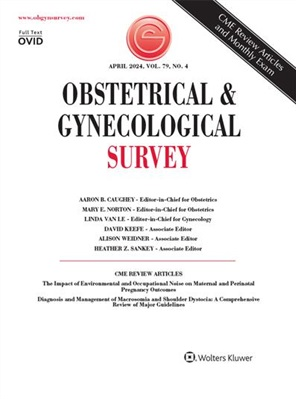Effectiveness and Safety of Prenatal Valacyclovir for Congenital Cytomegalovirus Infection: Systematic Review and Meta-analysis
IF 3.6
4区 医学
Q1 OBSTETRICS & GYNECOLOGY
引用次数: 0
Abstract
ABSTRACT One of the most common causes of infection-related fetal malformations is congenital cytomegalovirus (CMV), which affects approximately 0.5% to 2% of newborns. Several approaches have been investigated for screening, prevention, and treatment; one drug that shows activity against CMV is valacyclovir, and prenatal administration of this drug has been investigated in the context of preventing fetal disorders due to CMV. Although studies and clinical trials have been done regarding the safety and effectiveness of valacyclovir, clinical attitudes regarding universal CMV screening and prenatal valacyclovir treatment have yet to change. This article is a systematic review and meta-analysis of the safety and effectiveness of prenatal valacyclovir in CMV-infected pregnancies. Inclusion criteria included pregnancies with CMV infection diagnosed through serology, with a primary outcome of incidence of congenital CMV confirmed by polymerase chain reaction from amniocentesis. Secondary outcomes included symptomatic infection (rash, jaundice, microcephaly, seizures, hepatosplenomegaly, hearing loss, visual loss, retinitis, and central nervous system anomalies), asymptomatic infection, perinatal death, pregnancy termination, fetal anomaly, or severe symptoms. Adverse events related to the administration of valacyclovir were also recorded. Because relatively few studies were available for inclusion, the authors were unable to assess publication bias, but other risk of bias was assessed using standard tools. Final analysis included 8 studies and 620 pregnant women with CMV in 2 randomized controlled trials and 6 observational studies. One randomized controlled trial focused on valacyclovir treatment for CMV infection acquired in early pregnancy, and the other assessed valacyclovir treatment between 34 and 38 weeks' gestation to reduce risk of CMV within 1 year of delivery. The latter of the 2 studies was not included in pooled data synthesis because of inclusion criteria differences. Three studies focused on valacyclovir treatment for confirmed maternal CMV infection; pooled data analysis showed that valacyclovir-treated pregnancies had lower risk of congenital CMV (odds ratio [OR], 0.37; 95% confidence interval [CI], 0.21–0.64; P < 0.001). When contracted in the first trimester, risk of vertical transmission was lower in those who were treated with valacyclovir (OR, 0.34; 95% CI, 0.15–0.74; P = 0.001); however, there was no effect observed in those with CMV in the periconceptual period. Analysis additionally showed that prenatal valacyclovir treatment was more likely to result in asymptomatic children (OR, 2.98; 95% CI, 1.18–7.55; P = 0.021), but no other significant perinatal differences were observed. These results show that treatment of CMV with prenatal valacyclovir reduces the risk of congenital CMV and its associated complications. Limitations of this analysis include the heterogeneity of inclusion and measurement criteria, as well as small samples to assess perinatal outcomes. Risks associated with the drug were small, and adverse events resolved after patients discontinued valacyclovir. The findings are consistent with previous research showing the benefit of valacyclovir. Further research should assess perinatal outcomes associated with valacyclovir treatment, as well as the role of valacyclovir in secondary versus primary infection. In particular, larger randomized controlled trials should be implemented to determine the association of valacyclovir treatment with the risk of fetal structural anomalies, symptomatic infection, and neurocognitive impairment.产前缬昔洛韦治疗先天性巨细胞病毒感染的有效性和安全性:系统评价和荟萃分析
感染相关胎儿畸形的最常见原因之一是先天性巨细胞病毒(CMV),影响约0.5%至2%的新生儿。已经研究了几种筛查、预防和治疗方法;一种显示抗巨细胞病毒活性的药物是valacyclovir,产前给药这种药物已经在预防巨细胞病毒引起的胎儿疾病的背景下进行了研究。尽管关于valacyclovir安全性和有效性的研究和临床试验已经完成,但临床对通用巨细胞病毒筛查和产前valacyclovir治疗的态度尚未改变。这篇文章是一个系统的回顾和荟萃分析的安全性和有效性产前缬昔洛韦在巨细胞病毒感染的妊娠。纳入标准包括通过血清学诊断为巨细胞病毒感染的妊娠,主要结局是羊膜穿刺术的聚合酶链反应证实先天性巨细胞病毒的发病率。次要结局包括症状性感染(皮疹、黄疸、小头畸形、癫痫发作、肝脾肿大、听力丧失、视力丧失、视网膜炎和中枢神经系统异常)、无症状感染、围产期死亡、终止妊娠、胎儿异常或严重症状。与服用伐昔洛韦有关的不良事件也被记录下来。由于可纳入的研究相对较少,作者无法评估发表偏倚,但使用标准工具评估了其他偏倚风险。最终分析包括8项研究和620名巨细胞病毒孕妇,其中2项随机对照试验和6项观察性研究。一项随机对照试验侧重于valacyclovir治疗妊娠早期获得的巨细胞病毒感染,另一项试验评估valacyclovir治疗妊娠34至38周之间以降低分娩后1年内巨细胞病毒的风险。由于纳入标准不同,后一项研究未纳入汇总数据综合。三项研究聚焦于伐昔洛韦治疗确诊的母体巨细胞病毒感染;综合数据分析显示,服用伐昔洛韦的孕妇发生先天性巨细胞病毒的风险较低(优势比[OR], 0.37;95%置信区间[CI], 0.21-0.64;P & lt;0.001)。当在妊娠早期感染时,接受伐昔洛韦治疗的患者垂直传播的风险较低(OR, 0.34;95% ci, 0.15-0.74;P = 0.001);然而,在围孕期的巨细胞病毒患者中没有观察到任何影响。分析还显示,产前使用伐昔洛韦治疗更有可能导致无症状儿童(OR, 2.98;95% ci, 1.18-7.55;P = 0.021),但其他围产儿差异无统计学意义。这些结果表明,产前使用伐昔洛韦治疗巨细胞病毒可降低先天性巨细胞病毒及其相关并发症的风险。该分析的局限性包括纳入和测量标准的异质性,以及评估围产期结局的小样本。与该药物相关的风险很小,并且在患者停用valacyclovir后不良事件得到解决。这一发现与先前的研究一致,表明了valacyclovir的益处。进一步的研究应该评估与valacyclovir治疗相关的围产期结局,以及valacyclovir在继发性感染和原发性感染中的作用。特别是,应该实施更大规模的随机对照试验,以确定伐昔洛韦治疗与胎儿结构异常、症状性感染和神经认知障碍风险的关系。
本文章由计算机程序翻译,如有差异,请以英文原文为准。
求助全文
约1分钟内获得全文
求助全文
来源期刊
CiteScore
2.70
自引率
3.20%
发文量
245
审稿时长
>12 weeks
期刊介绍:
Each monthly issue of Obstetrical & Gynecological Survey presents summaries of the most timely and clinically relevant research being published worldwide. These concise, easy-to-read summaries provide expert insight into how to apply the latest research to patient care. The accompanying editorial commentary puts the studies into perspective and supplies authoritative guidance. The result is a valuable, time-saving resource for busy clinicians.

 求助内容:
求助内容: 应助结果提醒方式:
应助结果提醒方式:


